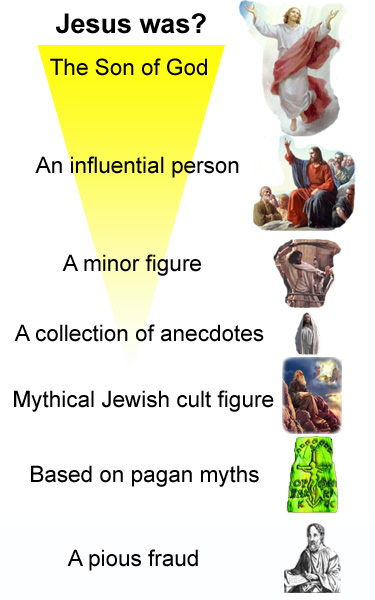(1) The Gospels are inerrant and absolutely historically true. Jesus is the Son of God who was predicted by the Hebrew scriptures, who came to earth in human form, was born of a virgin, preached, and was crucified by Pilate, then rose from the dead and now sits on the right hand of God. The Gospels are historical eyewitness accounts or based on solid eyewitness accounts.
(2) The Gospels are generally true but somewhat exaggerated accounts of a real Jesus who had a following of people who thought he was the Son of God. He wasn't born of a virgin and didn't walk on water or perform miracles or rise from the dead, but the Gospels reflect his true teachings and the basic events of his life, and he was crucified by Pilate. The Gospels come from eye witness accounts mixed with a little legend.
(3) The Gospels are generally true but somewhat exaggerated accounts of a real Jesus who was influential in the region. He may or may not have really been crucified by Pilate. He was later mythologized and elevated in status. The Gospels come from eye witness accounts mixed with legend.
(4) The Gospels are mostly fabricated stories inspired by a real Jesus. The Gospels come almost entirely from legends and scriptures, but are still loosely based on the actions of a real Jesus whom we don't know very much about.
(5) The Gospels are mostly fabricated stories inspired by a real person or persons from a spectrum of time, perhaps from events as far back as 200 years before the supposed life of Jesus. Over time stories were put together that cobbled various political events and persons into a single "Jesus Christ" figure. The events and teachings in the Gospels are mythologized, but based on real-life events that took place over time and were done by a person or various people. The Gospels come almost entirely from legends and scriptures, but are still based on the actions of some real people, without which the story of Jesus would never have come into existence.
(6) The Gospels are completely fabricated stories based on scripture, legends, and the mystical beliefs of existing Jewish cults. There is no human figure at the center of the Gospel stories at all. The Gospels were generally written in the same manner that most scholars claim, during the late 1st century to early 2nd century, but there is no person at the core of them, whether all of the writers themselves knew it or not.
(7) The Gospels are completely fabricated stories based on pagan myths about figures such as Dionysus and Mithras. The Gospels were written by directly mixing Jewish and non-Jewish religions and beliefs into stories that borrow from both traditions. The meaning of the Gospels has been largely lost and generally has little to do with Judaism.




